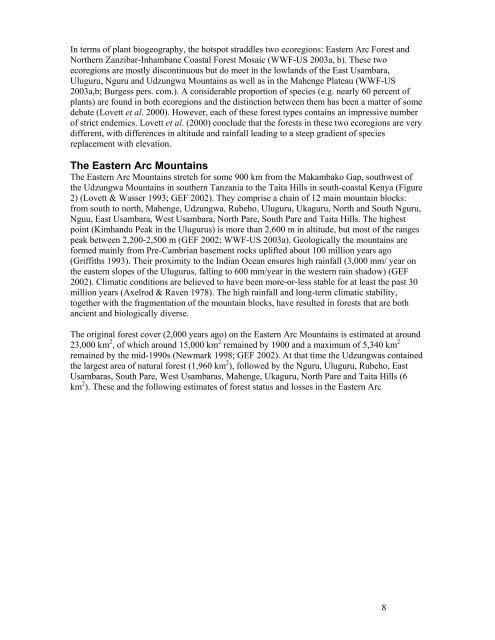During this time, awareness <strong>of</strong> the biodiversity values <strong>of</strong> the East African coastal forests hadalso grown. In 1983, a team from the International Council for Bird Preservation (ICBP, nowBirdLife International) surveyed the avifauna <strong>of</strong> Arabuko-Sokoke Forest on the north coast <strong>of</strong><strong>Kenya</strong> <strong>and</strong> drew attention to its globally threatened bird species (Kelsey & Langton, 1984). Adetailed survey (Roberston, 1987) <strong>of</strong> the sacred Kaya <strong>Forests</strong> (conserved by the Mijikenda, agroup <strong>of</strong> nine tribes on the <strong>Kenya</strong>n coast) highlighted their conservation importance for trees<strong>and</strong> led to a comprehensive survey <strong>of</strong> <strong>Kenya</strong>n coastal forests commissioned by WWF(Robertson & Luke 1993). This focussed on the plant species <strong>and</strong> on the status <strong>of</strong> the forests <strong>and</strong>made recommendations for their conservation.The Frontier-<strong>Tanzania</strong> <strong>Coastal</strong> Forest Research Programme carried out a series <strong>of</strong> biodiversitysurveys from 1989 to 1994 (Lowe & Clarke 2000; Clarke et al. 2000; Burgess et al. 2000;Broadley & Howell, 2000; H<strong>of</strong>fman 2000). In 1993 a workshop on the East African coastalforests was held in Dar es Salaam. This raised the pr<strong>of</strong>ile <strong>and</strong> conservation action in these forests<strong>and</strong> led to a series <strong>of</strong> status reports on the conservation <strong>and</strong> management <strong>of</strong> the <strong>Tanzania</strong>ncoastal forests (Clarke 1995; Clarke & Dickenson 1995; Clarke & Stubblefield 1995). These <strong>and</strong>other studies are summarized in another l<strong>and</strong>mark publication for the hotspot (Burgess &Clarke, 2000).More recently, WWF-EARPO organised a series <strong>of</strong> workshops to develop an <strong>Eastern</strong> Africa<strong>Coastal</strong> Forest Programme covering <strong>Kenya</strong>, <strong>Tanzania</strong> <strong>and</strong> Mozambique (WWF-EARPO, 2002).Thirty-one scientists <strong>and</strong> stakeholders from these three countries attended a regional workshopin Nairobi in February 2002. It aimed at developing a regional synthesis on coastal forestresource issues <strong>and</strong> a vision, strategy <strong>and</strong> way forward for realising the coastal forestprogramme. There was a strong focus on country-based group work. Maps <strong>of</strong> the region wereupdated, threats <strong>and</strong> root causes were analyzed, country conservation targets were agreed on <strong>and</strong>preliminary logframe action plans were developed for each country. National <strong>Coastal</strong> ForestTask Force meetings in each <strong>of</strong> the three countries subsequently refined these action plans. Thedocument resulting from the February 2002 workshop includes comprehensive annexes whichlist the coastal forest sites (showing their locations, areas, status, altitudes <strong>and</strong> threats) <strong>and</strong> theendemic animals, as well as the threat analysis <strong>and</strong> country action plans. A list <strong>of</strong> endemicplants, taken from Burgess & Clarke 2000, was supplied to the workshop but not included in thereport.On 12 March 2003, a CEPF workshop was held in Dar es Salaam to define the investment nichefor CEPF, building on all the previous effort. Participants included 48 people from scientific <strong>and</strong>research institutions, government departments, NGOs, field projects <strong>and</strong> donor organizations, all<strong>of</strong> whom worked in or had knowledge <strong>of</strong> the hotspot. The outputs from the workshop weresubsequently incorporated into a wide-ranging consultation process that helped to define theinvestment priorities for CEPF in this hotspot.Geography <strong>of</strong> the HotspotThe <strong>Eastern</strong> <strong>Arc</strong> <strong>Mountains</strong> <strong>and</strong> <strong>Coastal</strong> <strong>Forests</strong> hotspot runs along the <strong>Tanzania</strong>n <strong>and</strong> <strong>Kenya</strong>ncoasts from the border with Somalia to the north to that with Mozambique to the south (Figure1). The bulk <strong>of</strong> the hotspot is in its western expansion in <strong>Tanzania</strong>, which takes in the <strong>Eastern</strong><strong>Arc</strong> <strong>Mountains</strong> <strong>and</strong> the water catchment system <strong>of</strong> the Rufiji River. There is a narrow hook-likeextension <strong>of</strong> the hotspot near the <strong>Kenya</strong>/<strong>Tanzania</strong> border. This follows the <strong>Eastern</strong> <strong>Arc</strong><strong>Mountains</strong> to their northernmost limits in the Taita Hills in <strong>Kenya</strong>. The hotspot also projectsnorthwards for about 100 km in an extension that includes the forests <strong>of</strong> the Lower Tana Riverin <strong>Kenya</strong>. The hotspot includes the Indian Ocean isl<strong>and</strong>s <strong>of</strong> Mafia, Pemba <strong>and</strong> Zanzibar.7
In terms <strong>of</strong> plant biogeography, the hotspot straddles two ecoregions: <strong>Eastern</strong> <strong>Arc</strong> Forest <strong>and</strong>Northern Zanzibar-Inhambane <strong>Coastal</strong> Forest Mosaic (WWF-US 2003a, b). These twoecoregions are mostly discontinuous but do meet in the lowl<strong>and</strong>s <strong>of</strong> the East Usambara,Uluguru, Nguru <strong>and</strong> Udzungwa <strong>Mountains</strong> as well as in the Mahenge Plateau (WWF-US2003a,b; Burgess pers. com.). A considerable proportion <strong>of</strong> species (e.g. nearly 60 percent <strong>of</strong>plants) are found in both ecoregions <strong>and</strong> the distinction between them has been a matter <strong>of</strong> somedebate (Lovett et al. 2000). However, each <strong>of</strong> these forest types contains an impressive number<strong>of</strong> strict endemics. Lovett et al. (2000) conclude that the forests in these two ecoregions are verydifferent, with differences in altitude <strong>and</strong> rainfall leading to a steep gradient <strong>of</strong> speciesreplacement with elevation.The <strong>Eastern</strong> <strong>Arc</strong> <strong>Mountains</strong>The <strong>Eastern</strong> <strong>Arc</strong> <strong>Mountains</strong> stretch for some 900 km from the Makambako Gap, southwest <strong>of</strong>the Udzungwa <strong>Mountains</strong> in southern <strong>Tanzania</strong> to the Taita Hills in south-coastal <strong>Kenya</strong> (Figure2) (Lovett & Wasser 1993; GEF 2002). They comprise a chain <strong>of</strong> 12 main mountain blocks:from south to north, Mahenge, Udzungwa, Rubeho, Uluguru, Ukaguru, North <strong>and</strong> South Nguru,Nguu, East Usambara, West Usambara, North Pare, South Pare <strong>and</strong> Taita Hills. The highestpoint (Kimh<strong>and</strong>u Peak in the Ulugurus) is more than 2,600 m in altitude, but most <strong>of</strong> the rangespeak between 2,200-2,500 m (GEF 2002; WWF-US 2003a). Geologically the mountains areformed mainly from Pre-Cambrian basement rocks uplifted about 100 million years ago(Griffiths 1993). Their proximity to the Indian Ocean ensures high rainfall (3,000 mm/ year onthe eastern slopes <strong>of</strong> the Ulugurus, falling to 600 mm/year in the western rain shadow) (GEF2002). Climatic conditions are believed to have been more-or-less stable for at least the past 30million years (Axelrod & Raven 1978). The high rainfall <strong>and</strong> long-term climatic stability,together with the fragmentation <strong>of</strong> the mountain blocks, have resulted in forests that are bothancient <strong>and</strong> biologically diverse.The original forest cover (2,000 years ago) on the <strong>Eastern</strong> <strong>Arc</strong> <strong>Mountains</strong> is estimated at around23,000 km 2 , <strong>of</strong> which around 15,000 km 2 remained by 1900 <strong>and</strong> a maximum <strong>of</strong> 5,340 km 2remained by the mid-1990s (Newmark 1998; GEF 2002). At that time the Udzungwas containedthe largest area <strong>of</strong> natural forest (1,960 km 2 ), followed by the Nguru, Uluguru, Rubeho, EastUsambaras, South Pare, West Usambaras, Mahenge, Ukaguru, North Pare <strong>and</strong> Taita Hills (6km 2 ). These <strong>and</strong> the following estimates <strong>of</strong> forest status <strong>and</strong> losses in the <strong>Eastern</strong> <strong>Arc</strong>8
















